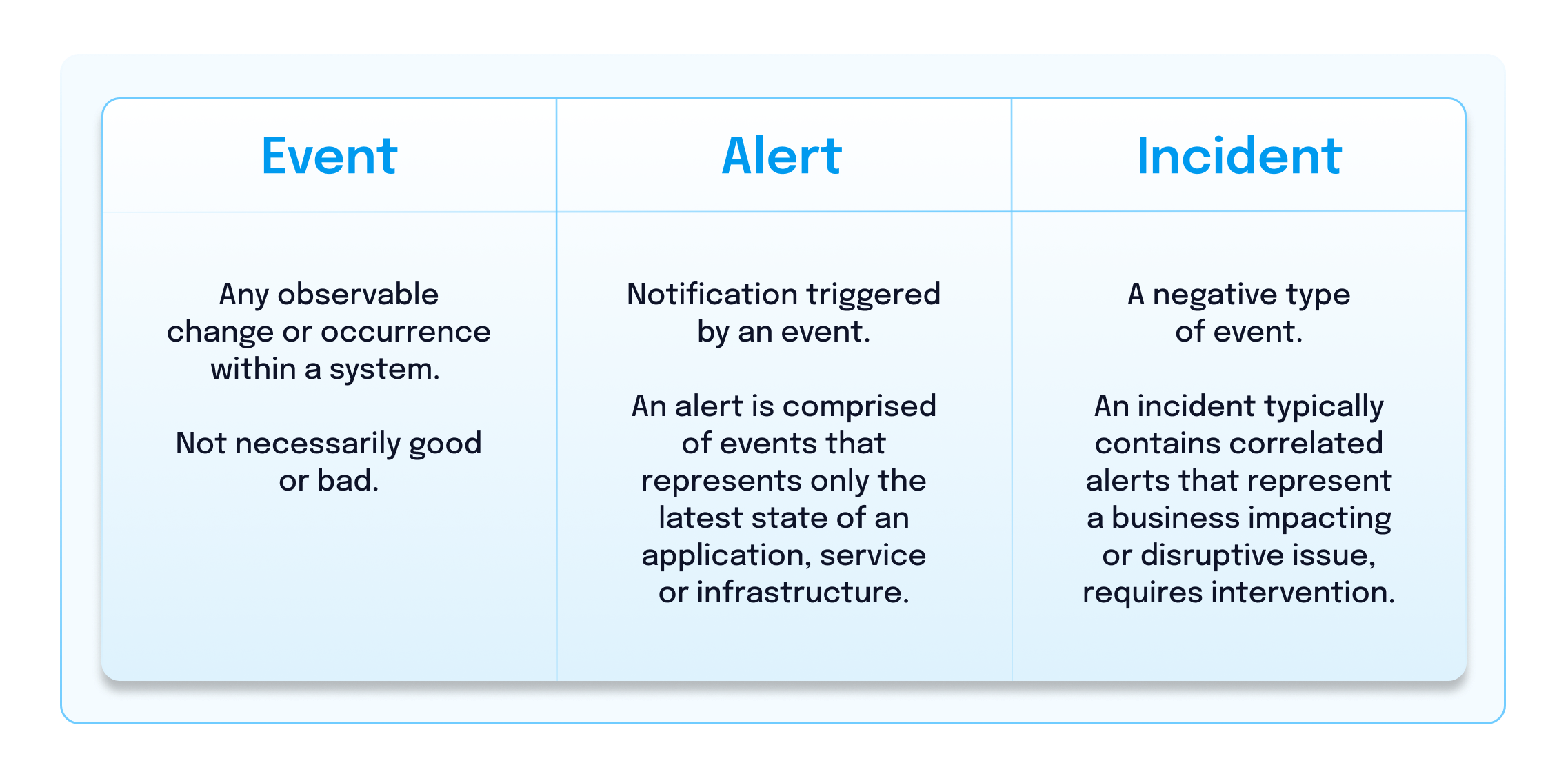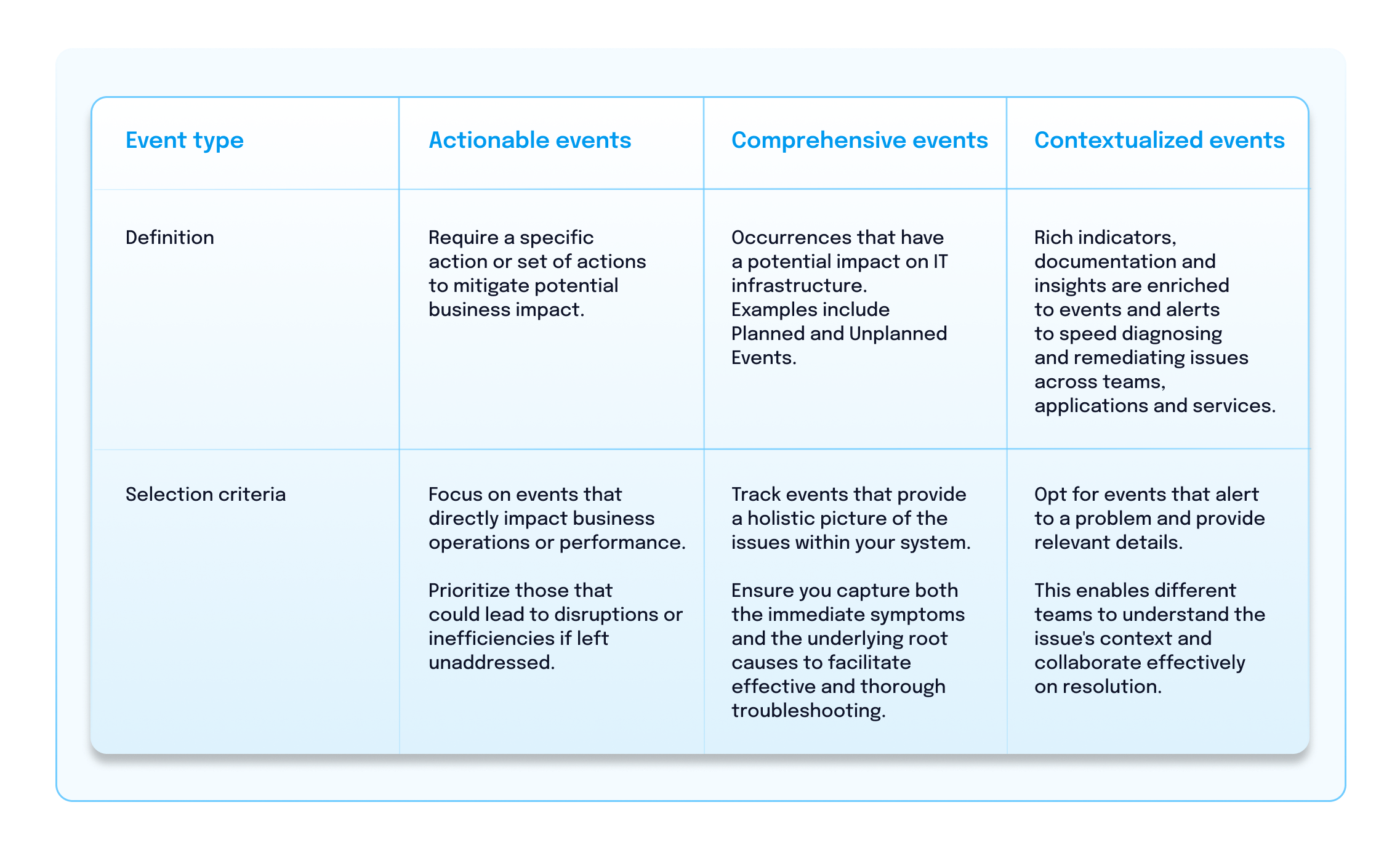Understand IT event analytics from basics to AIOps

A wise person once said, “What’s measured is what matters.” This couldn’t be more true than in the high-stakes world of IT operations, where the ability to swiftly measure, analyze, and respond to events is crucial for improving IT operational performance.
This post delves into defining IT event analytics, guiding you on getting started, showcasing real-world examples, and introducing essential methods to transforming your incident response strategy. Discover why optimizing your event analytics ensures you can efficiently identify, analyze, and address your IT incidents.
Read on to learn:
- What’s an event vs incident vs alert?
- What are event analytics in IT operations?
- Determine which events to measure and track
- Benefits of event analytics for incident management
- Improve your event data with event correlation
- Optimize your event analytics with AIOps
- Real-world examples of using event-based analytics
- Turn event analytics into meaningful insights with BigPanda
How are events, incidents, and alerts different?
- Event: An event, in the context of IT operations, refers to any observable change or occurrence within a system, which could be routine, informational, or indicative of issues. This can be in the form of log entries and regular status updates, which are recorded as event data in various databases and other files.
- Alert: An alert is a notification triggered by an event designed to inform stakeholders of a situation that needs attention.
- Incident: An incident is a specific kind of negative event that disrupts normal operations or services and requires intervention.
What are event analytics in IT operations?
Event analytics are measurements that show IT event performance. Monitoring systems generate these analytics, and understanding them gives teams insights into their IT environments’ performance and opportunities for improvement.
Common event types measured include system, application, database, network, and security events. These analytics aim to identify patterns, anomalies, and potential issues within event data.
Identify which events to measure and track
In deciding which events to measure or track, you must use the principles of actionable, comprehensive, and contextualized data. Here’s how to determine which events are worth measuring and tracking for your business:
Benefits of event analytics for incident management
Event analytics gives IT leaders vital insights into performance in their IT environments, helping identify trends such as mean resolution times, MTTx metrics, and outages.
Analytics is especially beneficial for IT teams handling large event volumes. They offer a systematic and efficient approach to managing and making sense of escalating amounts of events to promote streamlined and proactive IT management.
- Unified visibility: One of the challenges IT teams face is combatting the data fragmentation of tool sprawl. Ops solutions offer visibility and analytics into events across monitoring tools to deliver a unified and objective view of their IT environment in a single pane.
- Efficient noise reduction: With event analytic tools, you can filter out duplicate and non-actionable alerts to focus on critical incidents. This way, IT teams can prioritize attention and resources more effectively, enhancing overall efficiency.
- Proactive issue resolution: Leveraging AIOps data analytics and machine learning, IT teams can swiftly and accurately identify the root causes of issues. This proactive approach enables faster resolution and, in many cases, prevents potential problems before they escalate.
Improve event data with event correlation
Event correlation is the process of analyzing and identifying relationships between events to detect patterns, anomalies, and potential incidents. It involves collecting, normalizing, and aggregating event data from various sources, such as hardware, network traffic, and applications, and then applying techniques to identify meaningful connections between these events.
Enriching correlated events with operational and topology data sources such as CMDBs, APM tools, and network maps allows teams to identify and understand the relationships between various system events. With this visibility, teams can more effectively troubleshoot and resolve incidents, ultimately leading to improved system performance and availability.
Optimize your event analytics with AIOps
AIOps and incident management platforms use AI and machine learning algorithms to identify meaningful connections and relationships between disjointed IT infrastructure.
Advanced AIOps solutions can filter, deduplicate, and normalize alerts from different systems and use AI/ML to identify correlation patterns across thousands of events from all monitoring tools. This enables quicker, more accurate identification of incidents, workflow automation, and unified event analytics.
Other benefits of using AIOps for event analytics include:
- Enhance IT infrastructure: Pinpoint observability tools that offer substantial value and highlight those requiring reconfiguration or consolidation. Use AI/ML to intelligently streamline workflows, ensuring optimal efficiency during peak times, further contributing to cost savings.
- Reduce incident resolution time: With AIOps see your event analytics in real-time and consolidate events from various systems into a centralized platform. By simplifying and automating the analysis of multiple events, your team operates faster than with traditional methods. AIOps can also swiftly identify the likely root cause of issues, expediting the remediation and minimizing downtime and service disruptions.
- Optimize IT resources: In the past, measuring the effectiveness of IT teams posed serious challenges. However, with the integration of event analytics into your AIOps platform, you can enable data analysis, showcase your team’s measurable organizational contributions, and gain insights into their performance.
Case studies: Event analytics in the real world
IT event analytics is crucial for both observability tool consolidation and improving IT team efficiency. This is because event analytics plays a pivotal role in streamlining the detection and analysis of system events, reducing manual workload, and enabling IT teams to focus on rapid problem resolution.
Intercontinental Hotel Group improved IT tool consolidation
Utilizing BigPanda, Intercontinental Hotel Group (IHG) gained holistic awareness of their service operations by consolidating the events from siloed monitoring and observability tools into one centralized single pane of glass.
This removed the need to manually switch between separate tool consoles when responding to incidents. Additionally, it allowed them to identify and investigate underperforming tools, facilitating a more informed tool consolidation strategy.
“Centralizing our operations with AIOps and BigPanda allowed us to have a much earlier MTTD, I’m proud that we achieved 99.8% availability in 2022—our best performance on record.”
– Alvin Smith, Intercontinental Hotel Group
Zayo unlocked higher IT team efficiency
When an IT team aims to enhance efficiency in incident resolution, they can use event analytics to analyze their MTTx metrics and incident management KPIs. This lets them gain valuable insights into their baseline performance, identify where their resolution time is primarily allocated, and enable a focused approach to critical incidents.
Zayo experienced this transformational approach to incident management after becoming a BigPanda customer. Previously, their managed services business struggled to keep up with rapid growth, as they scaled 30% annually, adding 20,000 devices to oversee — well beyond team capacity.
BigPanda AIOps allows Zayo to automatically process huge event noise for a 99.991% reduction of their events. This dramatic decrease was achieved through de-duplication, false positive reduction, benign events filtration, and event aggregation into alerts with BigPanda Alert Intelligence for streamlined IT management.
Turn event analytics into meaningful insights
Empower your ITOps and DevOps teams to extract meaningful insights from event analytics with BigPanda. With our AI-powered alert filtering, enrichment, and robust reporting options, turning events into insight has never been easier.
Improve your event visibility and performance with our Unified Analytics, which aids ITOps teams with identifying problematic, noisy, or misconfigured tools that generate low-quality alerts. Instead, allow your teams to focus on high-value alerts, innovation, and enhancing the overall efficiency of incident response and resolution processes.
Sign up for a personalized demo to see how BigPanda can help you streamline and optimize your event analytics for true IT operational excellence.






